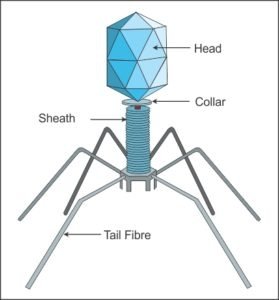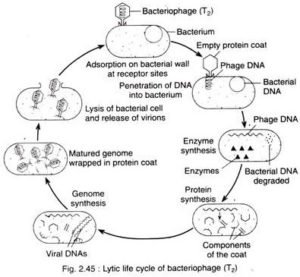CHAPTER THREE
3. VIRUSES
- VIRUSES are very small non-cellular organisms
- They can only be seen with the use of an electron microscope
- Viruses are found living only in living cells outside living cells. They are just non-living
- Viruses are entirely parasitic
- Each type of virus can cause a particular disease which is highly infectious
- Virus are link between non-living things and living things
- Virus diseases bring about immunity lie if one has the diseases the cannot have if the next time
//////////////////////////////////////////diagram virus////////////////////////////////////


Viruses have many shapes and sizes. There are three types of viruses namely animal virus, plant virus and bacteria virus.
The bacteria virus is called Bacteriophage
The virus has a bacteria virus which encloses the D.N.A OR R.N.A
D.N.A: DEOXYRIBOSE NUCLEIC ACID
R.N.A: RIBOSE NUCLEIC ACID
IT also has a collar a core end plates and short delicate tail fibers
A virus is not a cell because it lacks a nucleus and it lacks cytoplasm. The tail is used to attach the virus to the Bacteria and the bacteria is called the host. A virus can have a D.N.A OR R.N.A and this multiplies to produce new virus within a bacteria cell. The bacteria are called E-COLI. A virus which use bacteria to multiply in is called a bacterial virus. One process which bacterium have in common is that they reproduce
3.1. Why viruses are considered to be non-living
- They do not have a nucleus and cytoplasm
- They cannot reproduce outside a living cell
- They can be crystalized like non-living things
- They cannot grow
3.2. why viruses are considered to be living
- They have a genetic material (D.N.A, R.N.A)
- They are capable of reproducing like other living organism
3.3. REPRODUCTION OF VIRUS
When a bacterial virus attacks a bacteria, it attaches itself on the receptor site on the bacteria surface. It then produces enzymes, which dissolves the membrane of the host cell. The D.N.A or R.N.A is now sent into the host cell. This D.N.A or R.N.A takes control over the host D.N.A by combining with it and then reproduce many virus D.N.A which develop protein become new viruses.
////////////////////////////////////////diagram reproduction in bacteria ////////////////////////////////

The function of the protein counts of the virus is to protect the D.N.A or R.N.A
3.4 SOME DISEASES CAUSED BY VIRUSES
| Diseases | Causative agent | Symptom | Method of spread | Control |
| Poliomyelitis (infantile paralysis)
|
Polio Virus | Fever, headache | Air borne | Vaccination |
| Common Cold | Common cold virus | Bronchitis, irritation, sneezing, cough | Air Born | Avoid crowding, use handkerchief when coughing and sneezing |
| INFLUANZA | Influenza virus | Fever, headache, sore throat, muscle ache | Air borne | Vaccination |
| AIDS | HIV | Fever headache, rashes, diarrhea, loose of weight | Using unsterilized blade, syringes, shavers, sexual intercourse, blood transfusion | Avoid all the method of spread and Abstinence from sex |











